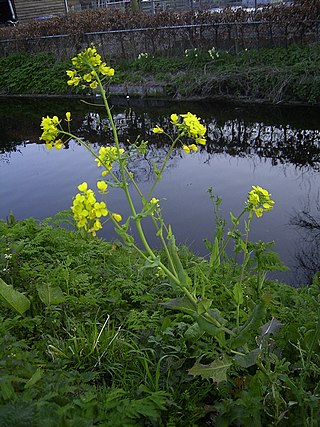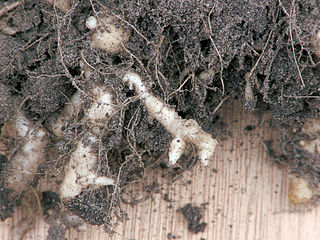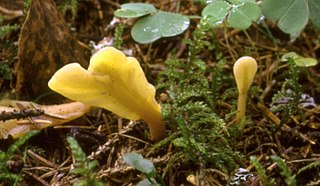
Cabbage, comprising several cultivars of Brassica oleracea, is a leafy green, red (purple), or white biennial plant grown as an annual vegetable crop for its dense-leaved heads. It is descended from the wild cabbage, and belongs to the "cole crops" or brassicas, meaning it is closely related to broccoli and cauliflower ; Brussels sprouts ; and Savoy cabbage.

Rusts are fungal plant pathogens of the order Pucciniales causing plant fungal diseases.

Rapeseed, also known as rape and oilseed rape, is a bright-yellow flowering member of the family Brassicaceae, cultivated mainly for its oil-rich seed, which naturally contains appreciable amounts of erucic acid. The term "canola" denotes a group of rapeseed cultivars that were bred to have very low levels of erucic acid and which are especially prized for use as human and animal food. Rapeseed is the third-largest source of vegetable oil and the second-largest source of protein meal in the world.

Corn smut is a plant disease caused by the pathogenic fungus Ustilago maydis. One of several cereal crop pathogens called smut, the fungus forms galls on all above-ground parts of corn species such as maize and teosinte. The infected corn is edible; in Mexico, it is considered a delicacy, called huitlacoche, often eaten as a filling in quesadillas and other tortilla-based dishes, as well as in soups.
Northern root-knot nematode is a species of vegetable pathogens which produces tiny galls on around 550 crop and weed species. They invade root tissue after birth. Females are able to lay up to 1,000 eggs at a time in a large egg mass. By surviving harsh winters, they can survive in cold climates.

The smuts are multicellular fungi characterized by their large numbers of teliospores. The smuts get their name from a Germanic word for 'dirt' because of their dark, thick-walled, and dust-like teliospores. They are mostly Ustilaginomycetes and comprise seven of the 15 orders of the subphylum. Most described smuts belong to two orders, Ustilaginales and Tilletiales. The smuts are normally grouped with the other basidiomycetes because of their commonalities concerning sexual reproduction.

Brassica rapa is a plant species growing in various widely cultivated forms including the turnip ; Komatsuna, napa cabbage, bomdong, bok choy, and rapini.

Clubroot is a common disease of cabbages, broccoli, cauliflower, Brussels sprouts, radishes, turnips, stocks, wallflowers and other plants of the family Brassicaceae (Cruciferae). It is caused by Plasmodiophora brassicae, which was once considered a slime mold but is now put in the group Phytomyxea. It is the first phytomyxean for which the genome has been sequenced. It has as many as thirteen races. Gall formation or distortion takes place on latent roots and gives the shape of a club or spindle. In the cabbage such attacks on the roots cause undeveloped heads or a failure to head at all, followed often by decline in vigor or by death. It is an important disease, affecting an estimated 10% of the total cultured area worldwide.
Leptosphaeria maculans is a fungal pathogen of the phylum Ascomycota that is the causal agent of blackleg disease on Brassica crops. Its genome has been sequenced, and L. maculans is a well-studied model phytopathogenic fungus. Symptoms of blackleg generally include basal stem cankers, small grey lesions on leaves, and root rot. The major yield loss is due to stem canker. The fungus is dispersed by the wind as ascospores or rain splash in the case of the conidia. L. maculans grows best in wet conditions and a temperature range of 5–20 degrees Celsius. Rotation of crops, removal of stubble, application of fungicide, and crop resistance are all used to manage blackleg. The fungus is an important pathogen of Brassica napus (canola) crops.

Plasmodiophora brassicae is a soilborne organism that is best known for its high economic impact on Brassica oil and vegetable crops. It infects 30 different cruciferous plants, which consists of up to 16 crop species, 9 ornamentals, and 5 weeds. The fungus on those plants causes a disease referred to as clubroot.

Urocystis agropyri is a fungal plant pathogen that causes flag smut on wheat.
Verticillium longisporum, also known as Verticillium Wilt, is a fungal plant pathogen that commonly infects canola. V. longisporum can attack other brassica plants as well as woody ornamentals. A main symptom of the infected plant is wilting. In America, V. longsiporum primarily effects eudicot plants. This pathogen can be very devastating and hard to eradicate, responding only to expensive fumigation or fungal resistant plants.
Sporisorium sorghi, commonly known as sorghum smut, is a plant pathogen that belongs to the Ustilaginaceae family. This fungus is the causative agent of covered kernel smut disease and infects sorghum plants all around the world such as Sorghum bicolor (sorghum), S. sudanense, S. halepense and Sorghumvulgare var. technichum (broomcorn). Ineffective control of S. sorghi can have serious economic and ecological implications.
Sporisorium reilianum Langdon & Full., (1978), previously known as Sphacelotheca reiliana, and Sporisorium reilianum, is a species of biotrophic fungus in the family Ustilaginaceae. It is a plant pathogen that infects maize and sorghum.

Spathularia flavida, commonly known as the yellow earth tongue, the yellow fan, or the fairy fan, is an ascomycete fungus found in coniferous forests of Asia, Europe and North America. It produces a small, fan- or spoon-shaped fruit body with a flat, wavy or lobed cream to yellow colored "head" raised on a white to cream stalk. The height is usually approximately 2–5 cm, and up to 8 cm. The fungus fruits on the ground in mosses, forest duff or humus, and fruit bodies may occur singly, in large groups, or in fairy rings. The spores produced by the fungus are needle-like, and up to 95 μm long. Several varieties have been described that differ largely in their microscopic characteristics. S. flavida has been described by authorities variously as inedible, of unknown edibility, or edible but tough.

Napa cabbage is a type of Chinese cabbage originating near the Beijing region of China that is widely used in East Asian cuisine. Since the 20th century, it has also become a widespread crop in Europe, the Americas and Australia. In much of the world, it is referred to as "Chinese cabbage". In Australia it is sometimes referred to as "wombok".

Urocystis is a genus of smut fungi containing plant pathogens, which infect grass species and other plants.

Ustilago esculenta is a species of fungus in the Ustilaginaceae, a family of smut fungi. It is in the same genus as the fungi that cause corn smut, loose smut of barley, false loose smut, covered smut of barley, loose smut of oats, and other grass diseases. This species is pathogenic as well, attacking Manchurian wild rice, also known as Manchurian ricegrass, Asian wild rice, and wateroat. This grass is its only known host.

Alternaria brassicicola is a fungal necrotrophic plant pathogen that causes black spot disease on a wide range of hosts, particularly in the genus of Brassica, including a number of economically important crops such as cabbage, Chinese cabbage, cauliflower, oilseeds, broccoli and canola. Although mainly known as a significant plant pathogen, it also contributes to various respiratory allergic conditions such as asthma and rhinoconjunctivitis. Despite the presence of mating genes, no sexual reproductive stage has been reported for this fungus. In terms of geography, it is most likely to be found in tropical and sub-tropical regions, but also in places with high rain and humidity such as Poland. It has also been found in Taiwan and Israel. Its main mode of propagation is vegetative. The resulting conidia reside in the soil, air and water. These spores are extremely resilient and can overwinter on crop debris and overwintering herbaceous plants.

Urocystis primulae is a fungal plant pathogen that infects several species of Primula.














